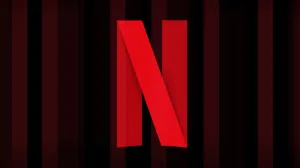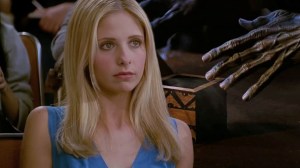Tonight, DC released the first six pages of Doomsday Clock #1, and there is a lot to unpack.
Videos by ComicBook.com
Writer Geoff Johns has said that he and artist Gary Frank can spend hours poring over a single panel, and that effort shows in what has been released so far: the six pages made available to fans at New York Comic Con are packed with content, plot, dialogue, meaning, and politics.
So much so, in fact, that when we sat down to try and break down the first six pages, we found that 2,000 words in, we had just barely finished writing about the first page.
In seven panels, Johns and Frank manage to do so much, say so much, and reference so much that just delving into what they are trying to do is taxing work.
So we are going to take a break for the night, and revisit the rest of the pages, one article at a time, throughout the next few days.
Meanwhile, let us know if we (somehow) missed something at @comicbook!
The Cover
While Rorschach’s sign in Watchmen warned that “The End is Near,” there is more of a sense of urgency on this cover.
“The end is here.”
That’s backed up in the text later, but we will get to that.
This image has been seen before, obviously, since it’s the standard cover to Doomsday Clock #1 — but what is interesting is that there is a spoiler in the ashcan version that was removed from the solicited cover.
In the bottom right corner, one of the protesters has a sign with a circle and slash through the face of Adrian Veldt. This was presumably to protect a spoiler that comes out later in the preview — that Doomsday Clock takes place years after Watchmen, when the world at large has discovered Veidt’s big lie.
That decision, to definitively answer the biggest question from the end of Watchmen, is one of a number of bold moves that shapes the first issue.

Page 1, Panel 1
The date of November 22 is relevant, of course, because it is the day John F. Kennedy was assassinated.
It is also 25 years to the day before the release of Doomsday Clock #1.
November 1992, meanwhile, is important in the real-world history of DC Comics; it was November 17 (or 18, depending on the venue) that Superman #75, “The Death of Superman,” hit the stands and ushered in the “platinum age” of comics.
The font, of course, is reminiscent of the lettering used for Rorschach’s journal in the original Watchmen, and tips the story’s hand for what is to come in a few pages.
Here, again, we see the “The End is Here” sign, another visual nod to Rorschach but also to the escalating and desperate situation faced by the world in this story.
The sign, incidentally, is angled in such a way that it points to one minute to midnight you line it up with a Doomsday Clock. That is significant because since shortly before Rebirth, there have been numerous items pitched in that angle during stories that have ties to Doctor Manhattan on the Watchmen throughout the DC Universe.
And lastly — and most importantly — we have the “..or maybe it’s the 23rd…” caption, which (as Johns noted in his panel) indicates that perhaps Rorschach is not a reliable narrator.

Page 1, Panel 2
The narration describes the carnage at the end of Watchmen, and it is clear that Rorschach has bought what Ozymandias was selling: there was a new beginning, he suggests, and humanity threw it away.
This is an interesting change of mentality, seeing as the last time we saw Rorschach he willingly let himself be killed rather than going along with Ozymandias’s plans. What could have led to such a change? Could he have been altered somehow when he returned from his “death” at the end of Watchmen? Is Manhattan responsible?
The reference to the “clock” having started over not only indicates that Rorschach believes the end of Watchmen provided the world with potential for a fresh start but also establishes the motif of clocks, which recurred throughout Watchmen and seems likely to do the same in Doomsday Clock.
While the “The end is here” sign is a portent of danger, and perhaps a sign of fear, it is not fear but anger on the faces of the protestors.
When Rorschach speaks of the missed opportunity at a fresh start, he says “but they blew it. All of them.” This suggests that he sees himself as above, or at least separate from, humanity at large.
This is not only a similar to the “…and I’ll look down and whisper ‘no’” monologue from Watchmen, but sets the tone for the rest of the page.

Page 1, Panel 3
As the image pulls out, the reveal of Ozymandias’s face on one of the protest signs is made visible, along with a “Make America Safe Again!!!” sign in the hands of another protester.
“Make America Safe Again” is an obvious play on “Make America Great Again,” the campaign slogan for U.S. President Donald Trump.
The placement of the narrative boxes is nearly identical here to the placement in Watchmen‘s third panel of the first page, which featured Walter Kovacs walking through the frame carrying his “the end is near sign.” Like Kovacs’s sign in the original, the “Make America Safe Again” sign is partially obscured by the top narrative box.
The anger that underlies the protest is explained here with the Ozymandias image — clearly the crowd is angry at him — but the presence of the “Make America Safe Again” poster further drives home that feeling, since anger at the status quo is so much of what drove Trump voters to the polls.
Rorschach describes American liberals as “The Undeplorables” here. Many Trump supporters took on the label of “deplorable” after Hillary Clinton, Trump’s opponent in the Presidential race, referred to some of Trump’s supporters as a “basket of deplorables” during a controversial speech.
American conservatives hold up the “basket of deplorables” comment as evidence that Clinton (and by extension the Democratic Party and/or the political establishment) do not take the Trump base seriously or offer them respect.
Almost everything Rorschach says in that third panel echoes regular conservative criticisms of American liberals: their protests are only for attention; they dislike the wealthy and successful; they live in an echo chamber and do not listen to opposing views; their tolerance of traditionally-oppressed groups is at odds with their unwillingness to live and let live with people who disagree with them.

Page 1, Panel 4
Rorschach’s critique of the right is not much less trenchant: “the totalitarians stand their ground, covering their eyes, preaching for a return to a rose-colored republic,” he says.
It is not subtle that, in that panel, we have panned out far enough to see police officers in riot gear, standing their ground against the protestors, their eyes literally covered by the plexiglass of their helmets.
Acknowledging that “for those not like them, the good old days weren’t so good” feels a bit at odds with Rorschach as a hardcore conservative which is a popular interpretation of Watchmen. It may indicate that his mindset has changed somewhat in the last few years — possibly for the same reason that he has warmed to Ozymandias’s plan?
More importantly, it positions him again as the outsider he seems to self-identify as: he has critiques for both sides.

Page 1, Panel 5
“God turned his back, left paradise to us,” Rorschach says, referring to Doctor Manhattan as a god.
This is something that both aligns with Superman and sets the pair apart: while writers, fans, and other characters often try to liken Superman to a god, the Man of Steel is resistant to those comparisons. As Johns noted in the Doomsday Clock panel at New York Comic Con, Superman is an alien who feels very human, while Doctor Manhattan is a human who feels very alien.
There is likely an argument to be made that the fury of the masses successfully overturning the police car, a symbol of the entrenched power structure, has some kind of metaphorical value for Trump’s anti-establishment, populist rhetoric, but that is likely looking too hard for meaning.
The crowd, meanwhile, enters from the top left, filling the fame in a way that makes everything feel as if it is tilted at the same angle as the sign in the first panel.

Page 1, Panels 6 and 7
Rorschach here seems resigned to the idea of nuclear war, saying that “soon the bugs will be all that’s left,” although there is some chance that he is speaking metaphorically because he talks about cockroaches and maggots “fighting over the scraps of the moderates.”
Johns has said that the book is about extremes, and how polarized the world has become, and in this way it seems like perhaps Rorschach is meant to be a more sympathetic narrator this time around than he was in Watchmen, when he seemed mostly crazy.
He says that the bugs will “eat themselves and finally choke — unless we bring god back down.”
There was a notion in Watchmen that humanity had become too reliant on Doctor Manhattan and that he had to distance himself from them in order for mankind to achieve their potential. This is a philosophy that felt like it was endorsed by Zack Snyder’s film adaptation of the story, which removed the squid monster at the end and replaced it with an attack by Doctor Manhattan, effectively forcing the “god” into exile.
In Doomsday Clock, it seems, the objective is the opposite: Rorschach specifically wants Manhattan back. So much so that he will bring the god back “kicking and screaming, because maybe we don’t deserve it.”
That is an interesting sentiment in light of recent DC media.

In the Wonder Woman movie, Ares insisted that mankind did not “deserve” Diana’s protection. Diana’s idealistic, humanistic response that “it’s not about deserve” effectively communicated not only what she learned from dealing with humanity, but the ethos that made her a hero to begin with (“who would I be if I stayed?” she asked her mother after being told that she would never be allowed to return to Themyscira).
In “The Oz Effect,” currently taking place in Action Comics and explicitly tied to Doomsday Clock, Jor-El is saying much the same to Superman, trying to get him to re-evaluate his relationship with mankind, which he believes to be doomed and tainted. “They don’t deserve you,” Jor-El tells his son in Action Comics #987.
The hand holding the broken bottle in the middle of the bottom panel has a shirt cuff that is reminiscent of fashions drawn by Dave Gibbons in Watchmen.

Page 1
As a whole, page one mirrors the first page of Watchmen, which started in close up on the splotch of blood on The Comedian’s button and zoomed out and up until it was being seen from the point of view of the police officers investigating his death.
Here, the eyes are from the street level instead: Rorschach considers himself an outsider, but nevertheless he is among the crowd, not above it.
The format mirroring page one of Watchmen is no accident: the nine-panel grid that was the storytelling spine of Moore and Gibbons’s work is retained throughout Doomsday Clock.









